ECO mode HONDA ACCORD COUPE 2000 CF / 6.G Owners Manual
[x] Cancel search | Manufacturer: HONDA, Model Year: 2000, Model line: ACCORD COUPE, Model: HONDA ACCORD COUPE 2000 CF / 6.GPages: 338, PDF Size: 4.82 MB
Page 9 of 338

Importan
t Safet y Precaution s
You'l l fin d man y safet y
recommendation s throughou t thi s
section , an d throughou t thi s manual .
Th e recommendation s o n thi s pag e
ar e th e one s w e conside r t o b e th e
mos t important .
Alway s Wea r You r Sea t Bel t
A sea t bel t i s you r bes t protectio n in
al l type s o f collisions . Airbag s
supplemen t sea t belts , bu t airbag s
ar e designe d to inflat e onl y in a
moderat e to sever e fronta l collision .
S o eve n thoug h you r ca r i s equippe d
wit h airbags , mak e sur e yo u an d
you r passenger s alway s wea r you r
sea t belts , an d wea r the m properly .
(Se e pag e 15 .)
Restrai n Al l Childre n
Childre n ar e safes t whe n the y ar e
properl y restraine d in th e bac k seat ,
no t th e fron t seat . A chil d wh o is to o
smal l fo r a sea t bel t mus t b e properl y
restraine d in a chil d safet y seat . (Se e
pag e 20 .) B
e Awar e o f Airba g Hazard s
Whil e airbag s ca n sav e lives , the y
ca n caus e seriou s o r fata l injurie s t o
occupant s wh o si t to o clos e t o them ,
o r ar e no t properl y restrained .
Infants , youn g children , an d shor t
adult s ar e a t th e greates t risk . B e
sur e t o follo w al l instruction s an d
warning s i n thi s manual . (Se e pag e
9 .)
Don' t Drin k an d Driv e
Alcoho l an d drivin g don' t mix . Eve n
on e drin k ca n reduc e you r abilit y t o
respon d t o changin g conditions , an d
you r reactio n tim e get s wors e wit h
ever y additiona l drink . S o don' t drin k
an d drive , an d don' t le t you r friend s
drin k an d drive , either . Contro
l You r Spee d
Excessiv e spee d is a majo r facto r i n
cras h injurie s an d deaths . Generally ,
th e highe r th e spee d th e greate r th e
risk , bu t seriou s accident s ca n als o
occu r a t lowe r speeds . Neve r driv e
faste r tha n is saf e fo r curren t
conditions , regardles s o f th e
maximu m spee d posted .
Kee p You r Ca r i n Saf e Conditio n
Havin g a tir e blowou t o r a
mechanica l failur e ca n b e extremel y
hazardous . T o reduc e th e possibilit y
o f suc h problems , chec k you r tir e
pressure s an d conditio n frequently ,
an d perfor m al l regularl y schedule d
maintenance . (Se e pag e 20 2 .)
Drive r an d Passenge r Safet y
Page 24 of 338

Protectin
g Childre n
Childre n Shoul d Si t i n th e Bac k
Sea t
Accordin g to acciden t statistics ,
childre n o f al l age s an d size s ar e
safe r whe n the y ar e restraine d in th e
bac k seat , no t th e fron t seat . Th e
Nationa l Highwa y Traffi c Safet y
Administratio n an d Transpor t
Canad a recommen d tha t al l childre n
age s 1 2 an d unde r b e properl y
restraine d in th e bac k seat .
I n th e bac k seat , childre n ar e les s
likel y t o b e injure d b y strikin g har d
interio r parts durin g a collisio n o r
har d braking . Also , childre n canno t
b e injure d b y a n inflatin g airba g
whe n the y rid e in th e back . Th
e Passenger' s Fron t Airba g
Pose s Seriou s Risk s t o Childre n
Fron t airbag s hav e bee n designe d to
hel p protec t adult s in a moderat e to
sever e fronta l collision . T o d o this ,
th e passenger' s fron t airba g is quit e
large , an d it inflate s wit h tremendou s
speed .
Infants
Never put a rear-facing child seat in the front seat of a vehicle equipped
with a passenger's front airbag. If
th e airba g inflates , i t ca n hi t th e bac k
of th e chil d sea t wit h enoug h forc e
t o kil l o r ver y seriousl y injur e a n
infant .
Small Children
Placing a forward-facing child seat in the front seat of a vehicle equipped
with a passenger's front airbag can
be hazardous. I f th e vehicl e sea t i s
to o fa r forward , o r th e child' s hea d is
throw n forwar d durin g a collision , a n
inflatin g fron t airba g ca n strik e th e
chil d wit h enoug h forc e t o kil l o r
ver y seriousl y injur e a smal l child .
Larger Children
Children who have outgrown child
seats are also at risk of being injured
or killed by an inflating passenger's
front airbag. Wheneve r possible ,
large r childre n shoul d si t i n th e bac k
seat , properl y restraine d wit h a sea t
belt . (Se e pag e 3 5 fo r importan t
informatio n abou t protectin g large r
children. )
CONTINUED
Drive r an d Passenge r Safet y
Page 28 of 338

Protectin
g Childre n
Small Children: A chil d wh o is to o
larg e fo r a rear-facin g chil d seat , an d
wh o ca n si t u p withou t support ,
shoul d b e restraine d in a forward -
facin g chil d seat . Se e pag e 3 2 fo r
additiona l informatio n o n protectin g
smal l children . 3. The child seat should fit the
vehicle seating position (or
positions) where it will be used.
Du e t o variation s i n th e desig n o f
chil d seats , vehicl e seats , an d sea t
belts , al l chil d seat s wil l no t fi t al l
vehicl e seating positions .
However , Hond a is confiden t tha t
on e o r mor e chil d sea t model s ca n fi t
an d b e properl y installe d in al l
recommende d seating position s i n
you r car . Befor
e purchasin g a chil d seat , w e
recommen d tha t parent s tes t th e
chil d sea t i n th e specifi c vehicl e
seatin g positio n (o r positions ) wher e
the y inten d t o us e th e seat . I f a
previousl y purchase d chil d sea t doe s
no t fit , yo u ma y nee d t o bu y a
differen t on e tha t wil l fit .
CONTINUED
Drive r an d Passenge r Safet y
Page 31 of 338
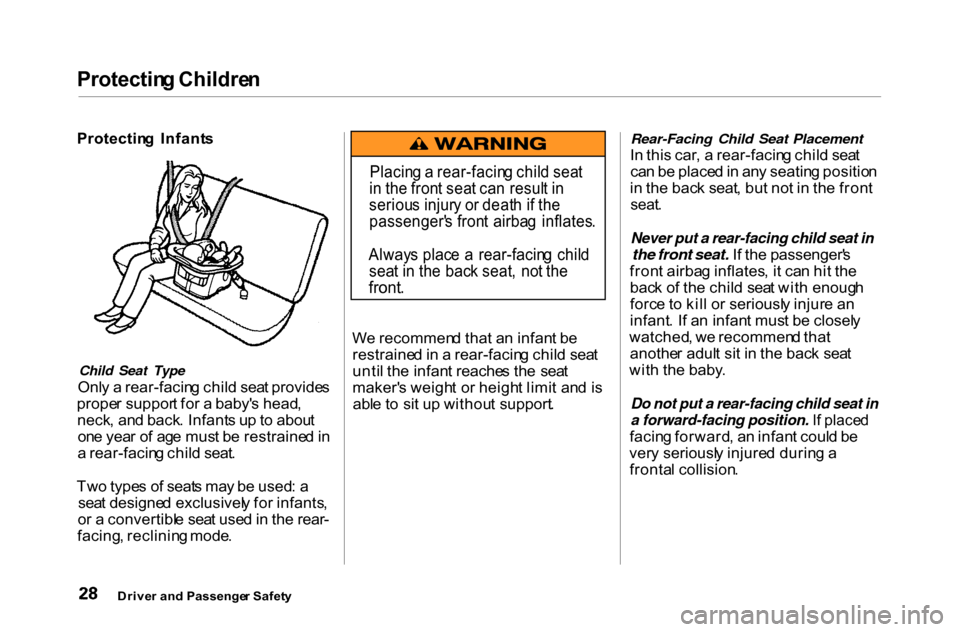
Protectin
g Childre n
Protectin g Infant s
Child Seat Type
Onl y a rear-facin g chil d sea t provide s
prope r suppor t fo r a baby' s head ,
neck , an d back . Infant s u p to abou t
on e yea r o f ag e mus t b e restraine d in
a rear-facin g chil d seat .
Tw o type s o f seat s ma y b e used : a
sea t designe d exclusivel y fo r infants ,
o r a convertibl e sea t use d in th e rear -
facing , reclinin g mode . W
e recommen d tha t a n infan t b e
restraine d in a rear-facin g chil d sea t
unti l th e infan t reache s th e sea t
maker' s weigh t o r heigh t limi t an d i s
abl e t o si t u p withou t support .
Rear-Facing Child Seat Placement
I n thi s car , a rear-facin g chil d sea t
ca n b e place d in an y seatin g positio n
i n th e bac k seat , bu t no t i n th e fron t
seat .
Never put a rear-facing child seat in
the front seat. I f th e passenger' s
fron t airba g inflates , i t ca n hi t th e
bac k o f th e chil d sea t wit h enoug h
forc e t o kil l o r seriousl y injur e a n
infant . I f a n infan t mus t b e closel y
watched , w e recommen d tha t
anothe r adul t si t i n th e bac k sea t
wit h th e baby .
Do not put a rear-facing child seat in
a forward-facing position. I f place d
facin g forward , a n infan t coul d b e
ver y seriousl y injure d durin g a
fronta l collision .
Drive r an d Passenge r Safet y
Placin
g a rear-facin g chil d sea t
i n th e fron t sea t ca n resul t i n
seriou s injur y o r deat h i f th e
passenger' s fron t airba g inflates .
Alway s plac e a rear-facin g chil d
sea t i n th e bac k seat , no t th e
front .
Page 46 of 338
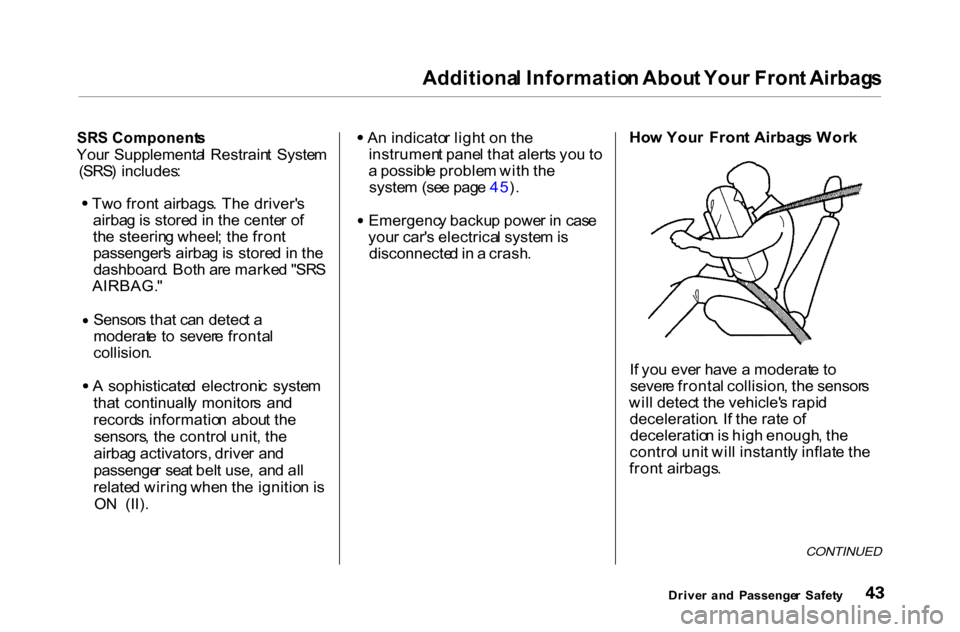
Additiona
l Informatio n Abou t You r Fron t Airbag s
SR S Component s
You r Supplementa l Restrain t Syste m
(SRS ) includes : Tw
o fron t airbags . Th e driver' s
airba g is store d in th e cente r o f
th e steerin g wheel ; th e fron t
passenger' s airba g is store d in th e
dashboard . Bot h ar e marke d "SR S
AIRBAG. " Sensor
s tha t ca n detec t a
moderat e t o sever e fronta l
collision . A
sophisticate d electroni c syste m
tha t continuall y monitor s an d
record s informatio n abou t th e
sensors , th e contro l unit , th e
airba g activators, driver an d
passenge r sea t bel t use , an d al l
relate d wirin g whe n th e ignitio n is
O N (II). A
n indicato r ligh t o n th e
instrumen t pane l tha t alert s yo u t o
a possibl e proble m wit h th e
syste m (se e pag e 45 ). Emergenc
y backu p powe r i n cas e
you r car' s electrica l syste m is
disconnecte d in a crash . Ho
w You r Fron t Airbag s Wor k
I f yo u eve r hav e a moderat e t o
sever e fronta l collision , th e sensor s
wil l detec t th e vehicle' s rapi d
deceleration . I f th e rat e o f
deceleratio n is hig h enough , th e
contro l uni t wil l instantl y inflat e th e
fron t airbags .
CONTINUED
Drive r an d Passenge r Safet y
Page 53 of 338
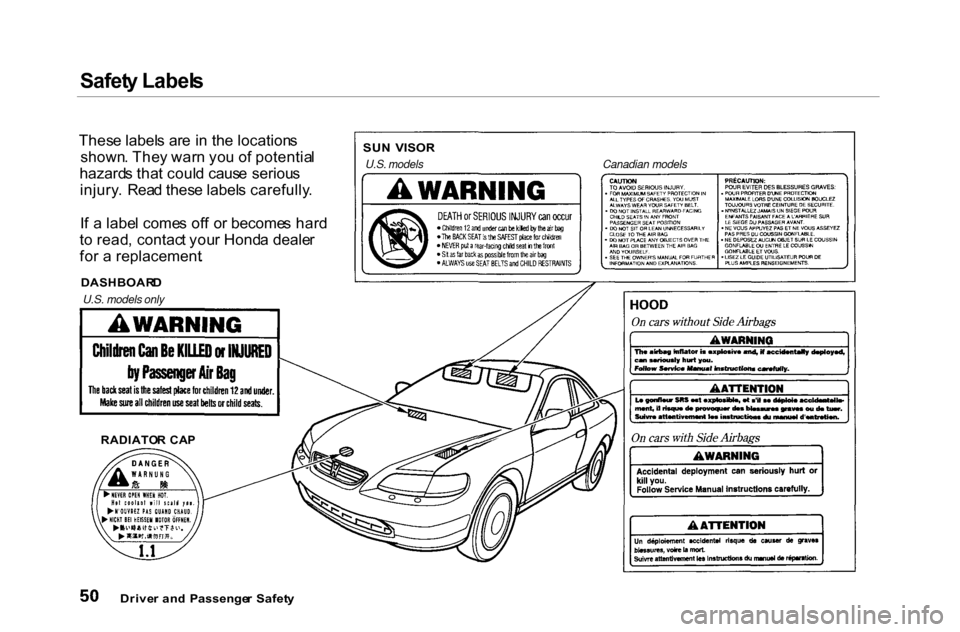
Safet
y Label s
Drive r an d Passenge r Safet y
U.S. models only
DASHBOAR
D
Thes
e label s ar e i n th e location s
shown . The y war n yo u o f potentia l
hazard s tha t coul d caus e seriou s
injury . Rea d thes e label s carefully .
I f a labe l come s of f o r become s har d
t o read , contac t you r Hond a deale r
fo r a replacement .
RADIATO R CA P
U.S. models
SU
N VISOR
Canadian models
Page 58 of 338

Indicato
r Light s
U.S .
Canad a
Anti-loc k Brak e Syste m
(ABS ) Indicato r
Only on models equipped with ABS (see
page 186)
Thi s ligh t normall y come s o n fo r a
fe w second s whe n yo u tur n th e
ignitio n switc h O N (II) , an d whe n
th e ignitio n switc h is turne d to
STAR T (lII) . I f thi s ligh t come s o n a t
an y othe r time , ther e is a proble m in
th e ABS. If thi s happens , tak e th e
ca r t o you r deale r t o hav e it checked .
Wit h th e ligh t on , you r ca r stil l ha s
norma l brakin g abilit y bu t n o anti -
lock . Fo r complet e information , se e
pag e 187 .
Supplementa
l Restrain t
Syste m Indicato r
Thi s indicato r light s whe n yo u tur n
th e ignitio n switc h O N (II) . I f i t
come s o n a t an y othe r time , i t
indicate s a potentia l proble m wit h
you r fron t airbags . O n model s
equippe d wit h sid e airbags , thi s ligh t
wil l als o aler t yo u to a potentia l
proble m wit h you r sid e airbag s o r
passenger' s sid e airba g automati c
cutof f system . Fo r complet e
information , se e pag e 4 5 .
Sid e Airba g Indicato r
Only on models equipped with side
airbags
Thi s indicato r light s whe n yo u tur n
th e ignitio n switc h O N (II) . I f i t
come s o n a t an y othe r time , i t
indicate s tha t th e passenger' s sid e
airba g ha s automaticall y shu t off .
Fo r complet e information , se e pag e
47 .
Immobilize
r Syste m
Indicato r
Thi s indicato r come s o n fo r a fe w
second s whe n yo u tur n th e ignitio n
switc h O N (II) . I t wil l the n g o of f i f
yo u hav e inserte d a properly-code d
ignitio n key . I f i t i s no t a properly -
code d key , th e indicato r wil l blin k
an d th e engin e wil l no t star t (se e
pag e 7 3 ) .
Thi s indicato r als o blink s severa l
time s whe n yo u tur n th e ignitio n
switc h fro m O N (II ) t o ACCESSOR Y
(I ) o r LOC K (0) .
Malfunctio n Indicato r
Lam p
Se e pag e 293 .
Instrument s an d Control s
A
B S
S
R S
SID E
AIRBA G
Page 66 of 338
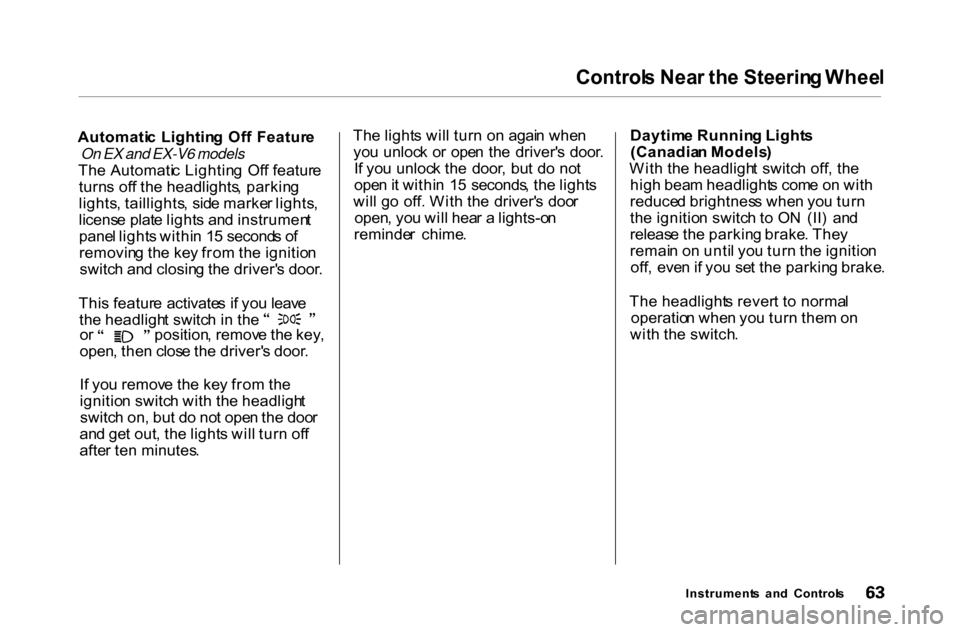
Control
s Nea r th e Steerin g Whee l
Automati c Lightin g Of f Featur e
On EX and EX-V6 models
Th e Automati c Lightin g Of f featur e
turn s of f th e headlights , parkin g
lights , taillights , sid e marke r lights ,
licens e plat e light s an d instrumen t
pane l light s withi n 1 5 second s o f
removin g th e ke y fro m th e ignitio n
switc h an d closin g th e driver' s door .
Thi s featur e activate s i f yo u leav e th
e headligh t switc h in th e o
r position , remov e th e key ,
open , the n clos e th e driver' s door .
I f yo u remov e th e ke y fro m th e
ignitio n switc h wit h th e headligh t
switc h on , bu t d o no t ope n th e doo r
an d ge t out , th e light s wil l tur n of f
afte r te n minutes . Th
e light s wil l tur n o n agai n whe n
yo u unloc k o r ope n th e driver' s door .
I f yo u unloc k th e door , bu t d o no t
ope n it withi n 1 5 seconds , th e light s
wil l g o off. Wit h th e driver' s doo r
open , yo u wil l hea r a lights-o n
reminde r chime . Daytim
e Runnin g Light s
(Canadia n Models )
Wit h th e headligh t switc h off , th e
hig h bea m headlight s com e o n wit h
reduce d brightnes s whe n yo u tur n
th e ignitio n switc h t o O N (II ) an d
releas e th e parkin g brake . The y
remai n o n unti l yo u tur n th e ignitio n
off , eve n if yo u se t th e parkin g brake .
Th e headlight s rever t t o norma l
operatio n whe n yo u tur n the m on
wit h th e switch .
Instrument s an d Control s
Page 76 of 338

Keys and Locks
These key s contai n electroni c
circuit s tha t ar e activate d b y th e
Immobilize r System . The y wil l no t
wor k t o star t th e engin e if th e
circuit s ar e damaged . Protec
t th e key s fro m direc t
sunlight , hig h temperature , an d
hig h humidity . D
o no t dro p th e key s o r se t heav y
object s on them . Kee
p th e key s awa y fro m liquids .
I f the y ge t wet , dr y the m immedi -
atel y wit h a sof t cloth .
Th e key s d o no t contai n batteries .
D o no t tr y t o tak e the m apart .
Remote Transmitter
Som e model s als o com e wit h tw o
remot e transmitters ; se e pag e 7 8 fo r
a n explanatio n o f thei r operation .
Immobilize
r Syste m
Th e Immobilize r Syste m protect s
you r ca r fro m theft . A properly -
code d maste r o r vale t ke y mus t b e
use d in th e ignitio n switc h fo r th e
engin e to start . I f a n improperly -
code d ke y (o r othe r device ) i s used ,
th e engine' s fue l syste m is disabled .
Whe n yo u tur n th e ignitio n switc h to
O N (II) , th e Immobilize r Syste m
indicato r shoul d com e o n fo r a fe w
seconds , the n g o out . I f th e indicato r
start s t o blink , i t mean s th e syste m
doe s no t recogniz e th e codin g o f th e
key . Tur n th e ignitio n switc h to
LOC K (0) , remov e th e key , reinser t
it , an d tur n th e switc h to O N (II )
again .
CONTINUED
Instrument s an d Control s
Page 81 of 338
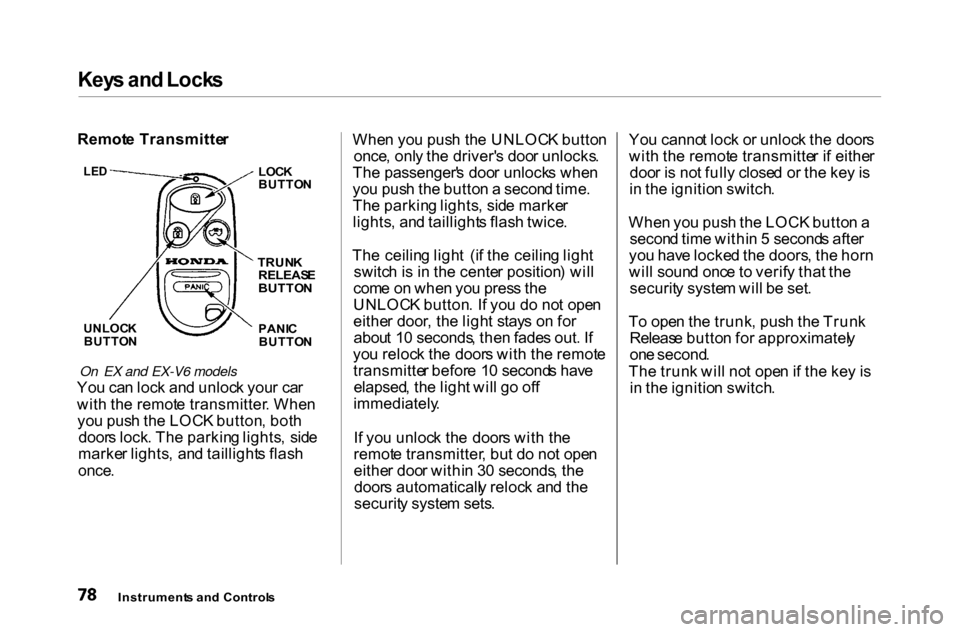
Key
s an d Lock s
Remot e Transmitte r
LE D
UNLOC K
BUTTO N LOC
K
BUTTO N
TRUN K
RELEAS E
BUTTO N
PANI C
BUTTO N
On EX and EX-V6 models
Yo u ca n loc k an d unloc k you r ca r
wit h th e remot e transmitter . Whe n
yo u pus h th e LOC K button , bot h
door s lock . Th e parkin g lights , sid e
marke r lights , an d taillight s flas h
once .
Whe
n yo u pus h th e UNLOC K butto n
once , onl y th e driver' s doo r unlocks .
Th e passenger' s doo r unlock s whe n
yo u pus h th e butto n a secon d time .
Th e parkin g lights , sid e marke r
lights , an d taillight s flas h twice .
Th e ceilin g ligh t (i f th e ceilin g ligh t
switc h is i n th e cente r position ) wil l
com e o n whe n yo u pres s th e
UNLOC K button . I f yo u d o no t ope n
eithe r door , th e ligh t stay s o n fo r
abou t 1 0 seconds , the n fade s out . I f
yo u reloc k th e door s wit h th e remot e
transmitte r befor e 1 0 second s hav e
elapsed , th e ligh t wil l g o of f
immediately .
I f yo u unloc k th e door s wit h th e
remot e transmitter , bu t d o no t ope n
eithe r doo r withi n 3 0 seconds , th e
door s automaticall y reloc k an d th e
securit y syste m sets . Yo
u canno t loc k o r unloc k th e door s
wit h th e remot e transmitte r i f eithe r
doo r i s no t full y close d o r th e ke y is
i n th e ignitio n switch .
Whe n yo u pus h th e LOC K butto n a
secon d tim e withi n 5 second s afte r
yo u hav e locke d th e doors , th e hor n
wil l soun d onc e t o verif y tha t th e
securit y syste m wil l b e set .
T o ope n th e trunk , pus h th e Trun k
Releas e butto n fo r approximatel y
on e second .
Th e trun k wil l no t ope n if th e ke y i s
i n th e ignitio n switch .
Instrument s an d Control s